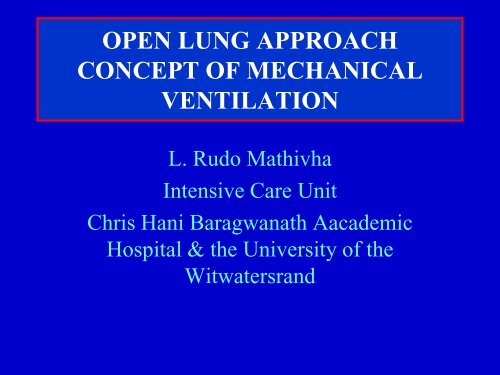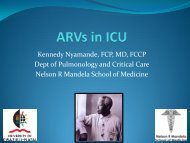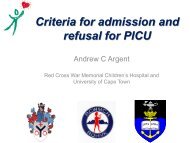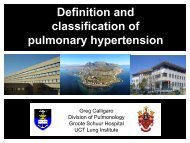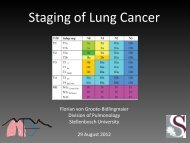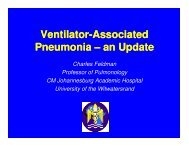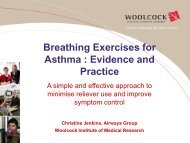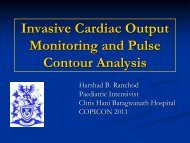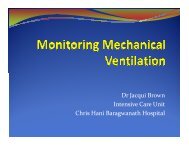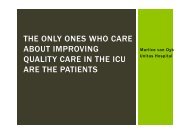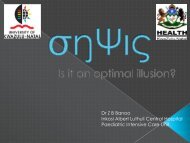open lung approach concept of mechanical ventilation
open lung approach concept of mechanical ventilation
open lung approach concept of mechanical ventilation
You also want an ePaper? Increase the reach of your titles
YUMPU automatically turns print PDFs into web optimized ePapers that Google loves.
OUTLINE• Introduction• Goals & Indications <strong>of</strong> Mechanical Ventilation• Physiology/Pathophysiology <strong>of</strong> MechanicalVentilation• Recruitment strategies/Open Lung <strong>concept</strong>• Choosing an Appropriate Ventilatory Strategy• Monitoring; Adverse Effects• Non-Conventional Approaches
WARNING/CAUTION• Do not attempt this if you have never seen a<strong>mechanical</strong> ventilator• Some <strong>of</strong> the principles may be harmful inNeonates• Learning and responsible practice will getyou with the programme!• Use strategy that suits your patient and youbest!
• HistoryINTRODUCTION• Vivisection work; PolioEpidemics• Conventional Ventilation• Principal mode in criticallyill patients• Initially for totally apnoeicpatients• Ventilator design• From Iron Lung to TotalSophistication• No ideal ventilator
INTRODUCTION• One <strong>of</strong> the key measures <strong>of</strong> patient outcome and thequality <strong>of</strong> care in ICU is ventilator-free days.• Ventilatory protocols for acutely ill patients in the ICUhave improved favourably over time.• Strategies have changed from optimizing convenientphysiology variables, such as O2 and CO2 levels, toprotecting the <strong>lung</strong> from injury and↓cytokinemodulation <strong>of</strong> the <strong>lung</strong>
PHYSIOLOGY OF MECHANICALVENTILATION• Positive pressure via ETT• Large pressures applied• Increase in Mean Intrathoracic Pressure• Decreased venous return and CO :– Compensated for by normal vascular reflexes– Pronounced in hypovolaemic patients and atextremely high mean airway pressures
PATHOPHYSIOLOGY OFMECHANICAL VENTILATION• The cycle <strong>of</strong> continuous expansion and collapse<strong>of</strong> alveoli in respiratory cycle structuralchanges by barotrauma and volutrauma, as wellas surfactant function and cytokinereleaseAlveolar collapse with improper<strong>mechanical</strong> <strong>ventilation</strong>(↓PEEP↑VT) activation <strong>of</strong> SIRS• Disruption <strong>of</strong> Alveolar gas membrane• Surfactant system dysfunction• The <strong>lung</strong> is an important causative part <strong>of</strong> aninflammation-induced systemic disease state MOF,not only a pulmonary disease process.
ARDS• Catastrophic pulmonary or non-pulmonary• event resulting in ALI & respiratory failure• Increased intrapulmonary shunt• Hypoxaemia• Decreased pulmonary compliance• Diffuse pulmonary infiltrates• Exclusion <strong>of</strong> left heart failure• Need for <strong>mechanical</strong> <strong>ventilation</strong>
Goals <strong>of</strong> Mechanical Ventilation• Optimise oxygen delivery and <strong>ventilation</strong>• Oxygenation• Carbon dioxide Removal• Minimise toxicity• Barotrauma• Volutrauma• Cardiorespiratory Interractions• Optimise patient work <strong>of</strong> breathing
VOLUTRAUMA:Stretch Injury-alters capillarytransmural pressures-causes breaks incapillary endothelium& epithelium-increases leak<strong>of</strong> proteinaceousmaterial
BAROTRAUMA-air-leak intopleural orinterstitialspace-tearing at bronchoalveolarjunction as<strong>lung</strong> is recruited &allowed to collapse-most occurs independent <strong>lung</strong> attransition zone
OPTIMISED LUNG VOLUMEhigh <strong>lung</strong> volume<strong>ventilation</strong> overdistendsresultingin volutraumalow <strong>lung</strong>volume<strong>ventilation</strong> tearsadhesivesurfaces
OPEN LUNG CONCEPT• The strategy <strong>of</strong> <strong>lung</strong> recruitment or <strong>open</strong><strong>lung</strong> <strong>concept</strong> (OLC) refers to the dynamicprocess <strong>of</strong> <strong>open</strong>ing previously collapsed<strong>lung</strong> units by ↑transpulmonary pressure.• The OLC may play an important role inpreventing ventilator-induced <strong>lung</strong> injury
LUNG RECRUITMENT Recruitment maneouvre controlled positive ventilatorypressure necessary to expand alveoli. In true alveolar collapse, the pressure needed foralveolar recruitment may reach above 70 cmH2O Alveolar bed may be <strong>open</strong>ed best using the deceleratingwave pattern <strong>of</strong> Methods vary: Sustained inflation with 30cmH2O for 30 -60 seconds High PEEP 20-40 cmH2O- then titrate down Proning + Higher PEEP Initial High Paw on HFOV for 60 seconds then back to transitioning Paw
LUNG RECRUITMENT ↑initial inspiratory pressure recruit collapsealveoli, then minimal pressure prevent <strong>lung</strong>from collapsing Intrapulmonary suction renewed collapse <strong>of</strong> alveoli PaO2↓,secretion management must be balance withalveolar recruitment Early OLC ( < 72hrs ) higher response rate, thisprobably related to the change from exudate to afibroproliferative process
Appropriate Ventilatory StrategySystematic Evaluation• Identify the pathophysiology <strong>of</strong> the patient• Evaluate available modes based on physiology,advantages, & disadvantages• Pathophysiology directed therapy:– hypothesis testing– “take your best guess”• Monitor for effects / side-effects <strong>of</strong> therapy– non-invasive: exam, CXR, graphics– invasive: ABG, SVO2, lactates
Practical Clinical GuideInitiating Ventilation• Open <strong>lung</strong>s first: Recruit!!!• Sustained Inflation; PEEP Titration; High Paw on HFOV• Volume limited:• TV = 4-6 ml/kg ; PEEP = 8-10 ; FIO2 =1.0• Rate: physiological limits for age• Pressure Limited• PIP = 20 ; PEEP = 8-10 ; FIO2 = 1.0• Rate: physiological limits for age• PSV: PEEP = 8-10; PS to give TV 6-8ml/kg
Monitoring Ventilatory TherapyClinical EvaluationBlood GasesPulse OximetryEnd Tidal CO2Airway GraphicsRadiologic studies
WeaningMeet weaning criteria• Primary condition reversed/improved• ideally no other organ support• Normal metabolic pr<strong>of</strong>ile• Decreased need for sedatives/relaxants• A-aDO2 less than 100• OI less than 13• Transitioning devises• What is comfortable for the patient
LUNG PROTECTIVE STRATEGIES• UNDERSTAND MODES OF VENTILATION• OPEN LUNG APPROACH• LOW TIDAL VOLUME STRATEGY• HIGH PEEP LOW PIP• PERMISSIVE HYPERCAPNIA IF POSSIBLE• LOW FIO 2 ASAP!
Consider Non Conventional Modes• High Frequency Oscillation• Partial Liquid Lung Ventilation• ECMO• Negative Pressure Ventilation
NON CONVENTIONAL MODES
CONCLUSION• Conventional Ventilation:• Tried & tested- still mainstay <strong>of</strong> vent support• Familiar with it• Adverse effects; Failure• Quest for “Zero” Lung Damage• Smarter ventilatory protocols• Don’t chase normal physiologic values in adiseased <strong>lung</strong>
ADIOS: I WILL BE BACK• L’HITRAOT• SIZOBONANA FUTHI• TILL WE MEET AGAIN• GO YA KA MAGORO GA SE GOTSWANA• LATER DUDES AND DUDDETTES• Au Revoir• RI do VHONANA• HASTA LA VISTA


